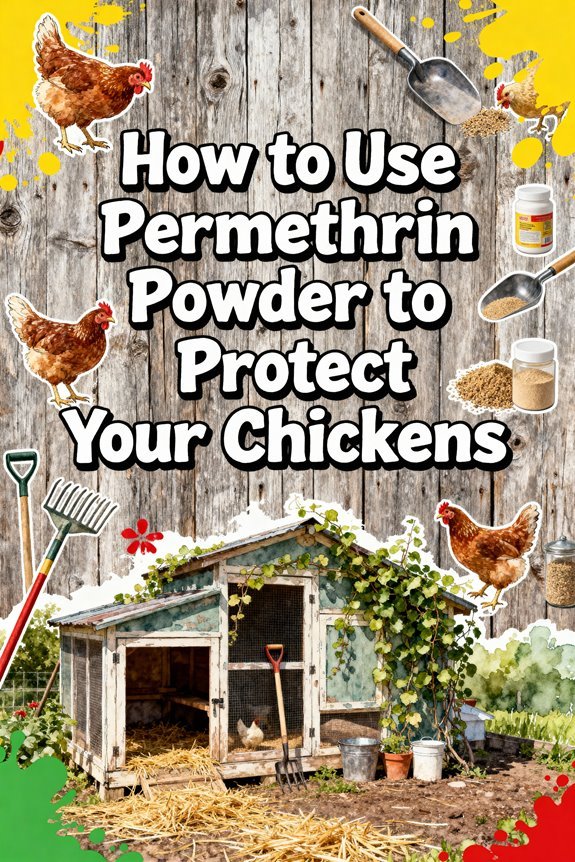How to Use Permethrin Powder to Protect Your Chickens
To protect your chickens with permethrin powder, you’ll need protective gear including gloves and eyewear. Apply the powder thoroughly to your birds’ feathers, focusing on the base, under wings, and vent areas while avoiding eyes and nostrils. Treat the entire coop after removing bedding, paying special attention to cracks and roosting areas. Schedule follow-up applications every week for 3-4 weeks, and monitor your flock for signs of reinfestation. Proper technique and timing are essential for ideal parasite control.
Safety Precautions and Required Equipment
Three critical safety aspects must be addressed before using permethrin powder on your chicken coop: personal protective equipment (PPE), proper handling protocols, and environmental safeguards.
For application safety, you’ll need proper personal protective equipment including protective gloves, eyewear, long-sleeve clothing, and pants. If you’re working in confined spaces, wear a respirator or dust mask. Don’t eat, drink, or smoke during application to prevent accidental ingestion. Since two people are required for effective treatment of chickens, ensure both handlers have appropriate safety gear.
Regular inspection of nesting areas is essential since mites often hide in cracks and crevices where chickens rest at night. Keep the product in its original, clearly labeled container and store it in a cool, dry area away from food, children, and pets. You’ll need to maintain a first aid kit nearby and keep the product’s Safety Data Sheet accessible. Before starting, verify you’ve removed all chickens from the treatment area and disposed of old bedding materials. Regular treatments are especially important during fall and winter when lice infestations commonly peak.
Step-by-Step Application on Chickens
Before applying permethrin powder to your chickens, you’ll need to establish a systematic treatment process that guarantees thorough coverage while maintaining both handler and bird safety.
Work with an assistant to hold each chicken upside down by its legs, exposing areas where infestation signs commonly appear. Apply generous amounts of powder to the base of feathers, under wings, and around the vent area. Gently massage the powder into the feathers to reach the skin where parasites hide. When treating the head region, carefully avoid the eyes and nostrils.
Let the bird shake off excess powder, which helps distribute the treatment evenly. Using proper application techniques, work methodically through your flock, treating each bird individually before returning it to your cleaned, treated coop. Even if some chickens appear healthy, treat the entire flock since feather loss and poor appearance may not be visible on all infected birds.
Treating the Coop and Surrounding Areas
Effective coop treatment requires a systematic approach to eliminate parasites from all potential hiding spots. Start by removing your chickens and thoroughly clearing out all bedding materials. You’ll need to dispose of contaminated materials far from the coop, ideally by burning them to prevent reinfestation. Maintain a layer of diatomaceous earth between bedding layers for ongoing protection. Consider installing hardware cloth panels around the coop’s foundation for enhanced predator protection. Consider planting persimmon trees nearby to provide nutritious seasonal treats that support chicken immune health.
Focus your permethrin application on pest hotspots like cracks, crevices, roosting bars, and wall joints. When mixing spray solutions, follow dilution guidelines precisely. For nest boxes, exercise caution during treatment to avoid egg contamination. After coop cleaning and treatment, extend your efforts to the run and surrounding areas, paying special attention to shaded spots where parasites congregate. Don’t forget to wear protective equipment during application and allow treated areas to dry completely before reintroducing chickens and fresh bedding.
Monitoring Results and Follow-Up Care
Successful permethrin treatment requires careful monitoring to guarantee complete parasite elimination. You’ll need to inspect your chickens weekly for 3-4 weeks, checking for adult lice and eggs at feather bases. Watch for signs of discomfort like excessive scratching or preening that might indicate ongoing infestation. Since the mite life cycle typically lasts 5-7 days, consistent monitoring is crucial for catching new hatchlings. Natural dust baths can help support your treatment efforts and prevent reinfestation. Using rolled cardboard traps can help detect mite presence early and determine if additional treatments are needed.
Implement proper monitoring techniques by conducting thorough physical examinations and documenting your findings. For effective retreatment scheduling, plan weekly follow-up applications for 3-4 weeks, but don’t exceed recommended frequency to avoid chemical exposure risks. You’ll need to wear protective gear during inspections and maintain detailed records of treatments and results. Remember to observe withdrawal periods for eggs and meat, and keep cats away from treated areas due to permethrin sensitivity. Contact a veterinarian if you notice adverse reactions in your flock.
Best Practices for Long-Term Prevention
Maintaining a robust prevention strategy after treatment will help you avoid future parasite infestations in your flock. You’ll need to implement integrated strategies that combine both chemical and non-chemical approaches to prevent mite resistance from developing.
Keep your coop dry and well-ventilated, as mites thrive in damp conditions. Consider rotating between permethrin and alternative treatments like Spinosad to maintain effective pest control. You’ll want to establish a regular inspection schedule to catch any signs of reinfestation early. Quarantine any new or sick birds before introducing them to your existing flock to prevent potential mite spread. Inspect chickens’ hock joints and other exposed skin areas nightly when mites are most active.
Make coop maintenance a priority by cleaning regularly and replacing bedding materials promptly. A secure welded wire enclosure can protect your chickens from predatory hawks while allowing them outdoor access. Document your treatment dates and methods, noting their effectiveness. This record-keeping will help you track patterns and adjust your prevention strategy as needed, ensuring long-term protection for your chickens.
Understanding Permethrin Products and Storage
To properly store and handle permethrin products, you’ll need to understand their various formulations and specific storage requirements. Permethrin formulations commonly come as dusting powders, emulsifiable concentrates, and sprays, typically containing 5% active ingredient for poultry use.
Store your permethrin products in their original containers at temperatures above 10°F (-12.2°C) in a cool, dry, well-ventilated area. Keep containers tightly sealed and away from moisture, heat sources, and oxidizing agents. You’ll need to maintain proper storage conditions by securing products in a locked area away from children and pets. When handling these products, always use appropriate protective equipment and wash thoroughly afterward. Never reuse containers for other purposes, and dispose of them according to local regulations. Maintain intact labels for safety information and application instructions.




